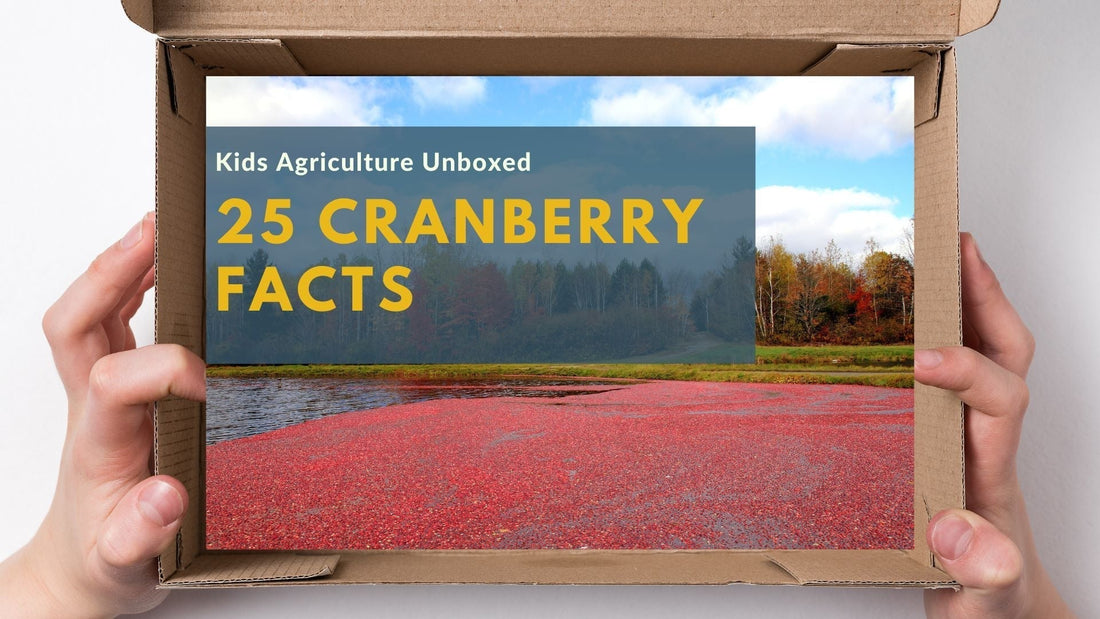Cranberries are one of America’s most unique fruits—bright red, tart, and packed with history! From floating bogs to Thanksgiving tables, these tiny berries have an incredible story rooted in U.S. agriculture. Whether you enjoy cranberry sauce, juice, or dried snacks, there’s much more to learn about how cranberries grow and the farmers who produce them.
1) North American originals
Cranberries are one of only a few fruits native to North America, alongside blueberries and Concord grapes. Indigenous peoples used them for food, dye, and traditional medicines, showing how long they’ve been part of life on this continent.
2) Low vines in special beds
Cranberries grow on low, woody vines rooted in sandy, acidic beds often called bogs or marshes. These perennial vines can live for decades—well-managed beds may remain productive for 50–100 years. They do decline in yield productivity over time.
3) Not grown “in water”
Cranberries don’t spend the growing season underwater. Farmers flood beds only at certain times—especially at harvest—because ripe berries float and are easier to gather from the water’s surface.
4) Why berries float
Cranberries contain tiny internal air pockets that help them float during water harvest. Those same pockets contribute to the classic “bounce test” used to check firmness and quality.
5) Fall harvest timing
Harvest usually happens from late September through early November in the U.S. That timing lines up with the holidays, which is why cranberries are closely associated with autumn meals.
6) A major U.S. specialty crop
The United States is one of the world’s largest cranberry producers. Production centers on cooler, sandy regions where growers can precisely manage water.
7) Wisconsin is #1
Wisconsin regularly produces more than half of the U.S. cranberry crop. The fruit is so important there that “cranberry” is the state fruit.
8) Massachusetts is #2
Massachusetts—especially Cape Cod and the southeastern coastal plain—has grown cranberries commercially for over 200 years. Historic farms and modern operations often sit side-by-side.
9) “Craneberry” origins
Early European settlers thought cranberry blossoms resembled a crane’s head and neck. Over time “craneberry” shortened to the name we use today.
10) Pemmican power food
Native Americans mixed crushed cranberries with dried meat and animal fat to make pemmican, a nutritious, long-keeping food. This portable energy source fueled travel and winter survival.
11) Nutrition in a tart package
Cranberries are rich in vitamin C and contain plant compounds (antioxidants) that give them their deep red color. Their natural tartness is why many cranberry products are sweetened.
12) The bounce test
In packing houses, cranberries roll down angled boards; firm, high-quality berries bounce and are separated from soft ones. It’s a simple, effective test that’s become part of cranberry lore.
13) Most are processed
Only a small share of the crop is sold fresh in bags for cooking and baking. The majority becomes juice, sauce, concentrates, and sweetened dried cranberries used in snacks and cereals.
14) Machines help at harvest
On wet harvests, water reels (also called “egg-beaters”) gently knock berries from the vines. The floating berries are then corralled and pumped or lifted out for cleaning.
15) Big yields per acre
A well-managed acre of cranberries can produce roughly 100–200 barrels in a good year (a barrel equals 100 pounds). That’s up to 10,000–20,000 pounds of fruit per acre.
16) Built-in defenses
Cranberries have a waxy skin and naturally acidic juice, which helps reduce some pest and disease pressures. Growers still scout carefully and use integrated pest management to protect vines.
17) How much we eat
Americans consume about 2 pounds of cranberries per person each year, mostly as juice blends or dried cranberries. Fresh cranberry sales usually peak around Thanksgiving.
18) Blueberry cousins
Cranberries and blueberries belong to the same plant family (Ericaceae) and prefer acidic soils. The large American cranberry’s scientific name is Vaccinium macrocarpon.
19) Flowers first, then fruit
Cranberry vines bloom in early summer with delicate pink flowers. Bees—often managed honey bees and native pollinators—are essential for good fruit set.
20) Flooding for protection
Beyond harvest, growers use controlled flooding to protect vines from spring and fall frosts. In cold regions, winter flooding forms an ice layer that shields buds from damaging temperatures.
21) Juice goes mainstream
Cranberry juice became a household favorite in the 1900s as processing improved. A grower-owned cooperative formed in 1930 helped expand markets and stabilize grower income.
22) Cleaning and sorting
After harvest, berries are washed to remove leaves and sand, then sorted by size, firmness, and color. Only the best fresh berries are bagged; the rest head to processors.
23) A holiday tradition
Cranberries likely appeared in early colonial sauces and stews, and today cranberry sauce is a classic U.S. Thanksgiving side. Dried cranberries also show up in stuffings, salads, and desserts.
24) Water stewardship matters
Cranberry farms rely on clean, carefully managed water stored in reservoirs, ditches, and ponds. Many operations recycle water between beds to reduce waste and protect local waterways.
25) Innovation in the bog
Modern cranberry farming uses tools like drones, soil moisture probes, and precision irrigation. These technologies help farmers apply water and nutrients efficiently and grow high-quality fruit with less environmental impact.
Why It’s Important to Teach Kids About the Cranberry Industry
Learning about cranberries helps youth connect science (soils, plant biology, and pollination) with real-world farming decisions (water management, pest control, and harvest methods). Understanding how specialty crops are grown builds appreciation for seasonal foods and the people who produce them. Cranberries also show how agriculture blends tradition with innovation to care for both crops and the environment.






